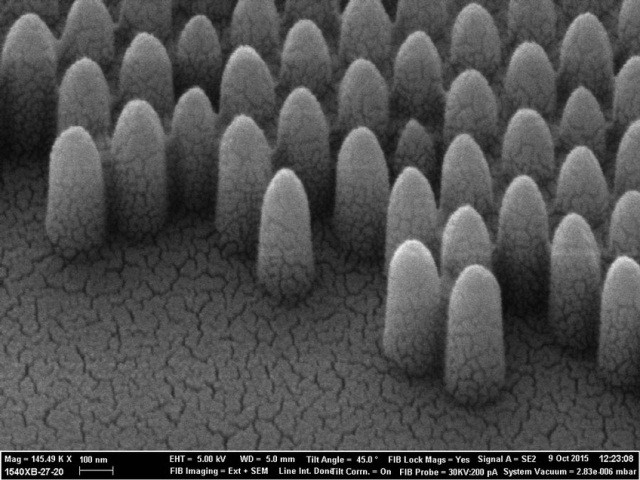Jan 22 2016
Researchers at the University College London (UCL) have developed a prototype smart window that could reduce heating bills, cut down window-cleaning costs, and improve productivity of employees working in high-rise office buildings.
 A scanning electron miscroscope photograph shows the pyramid-like nanostructures engraved onto glass: at 200nm they are 100 times smaller than a human hair. Controlling the surface morphology at the nanoscale allows scientists to tailor how the glass interacts with liquids and light with high precision.
A scanning electron miscroscope photograph shows the pyramid-like nanostructures engraved onto glass: at 200nm they are 100 times smaller than a human hair. Controlling the surface morphology at the nanoscale allows scientists to tailor how the glass interacts with liquids and light with high precision.
The revolutionary product was developed in collaboration with The Engineering and Physical Sciences Research Council (EPSRC). The prototype samples have demonstrated three major benefits; energy saving, self-cleaning, and anti-glare.
Energy-Saving
A thin film of vanadium dioxide, measuring 5 nm to 10 nm, is coated on the glass. In cold periods the film prevents heat loss by inhibiting thermal radiation escaping, during hot months the film prevents the sun’s infrared radiation from entering into the building. Vanadium dioxide is a cost-effective material and it is available in large quantities, combined with the thinness of the coating, it offers real sustainability and cost advantages over current gold and silver-based coatings.
Self-Cleaning
The smart window is highly water-resistant, resulting in any rain falling on the exterior of the window forming circular droplets that slide across the surface. The droplets remove dust, dirt and other similar contaminants effectively. This feature is attributed to the unique design of the glass, engraved with a pencil-like, conical design of nanostructures. The nanostructures trap air and ensure only a small amount of water is able to make contact with the glass surface. This configuration is different to standard glass, where droplets of rain cling to the surface of the glass and roll down slowly, leaving behind dirty marks.
Anti-Glare
The eyes of moths and similar insects have anti-reflective properties that protect them from predators. The design of the nanostructures provide the windows with the same anti-reflective properties and reduces the amount of internally reflected light to below five per cent, in contrast to the 20 to 30 per cent attained by other energy-saving windows coated with the prototype vanadium dioxide. The reduced glare helps in improving occupants comfort.
Dr Ioannis Papakonstantinou of UCL, project leader, explained that combining nanostructures with thermochromic coating is a new concept. The nanostructures improve the coatings thermochromics properties, resulting in a high-performance, self-cleaning smart window. According to the UCL researchers, smart windows can reduce heating bills by as much as 40 per cent, based on the building’s exact latitude, suggesting these smart windows could be suitable for tall buildings.
It’s currently estimated that, because of the obvious difficulties involved, the cost of cleaning a skyscraper’s windows in its first 5 years is the same as the original cost of installing them. Our glass could drastically cut this expenditure, quite apart from the appeal of lower energy bills and improved occupant productivity thanks to less glare. As the trend in architecture continues towards the inclusion of more glass, it’s vital that windows are as low-maintenance as possible. We also hope to develop a ‘smart’ film that incorporates our nanostructures and can easily be added to conventional domestic, office, factory and other windows on a DIY basis to deliver the triple benefit of lower energy use, less light reflection and self-cleaning, without significantly affecting aesthetics
Dr Ioannis Papakonstantinou, ULC
Professor Philip Nelson, Chief Executive of EPSRC said: "This project is an example of how investing in excellent research drives innovation to produce tangible benefits. In this case, the new technique could deliver both energy savings and cost reductions."
To advance the concept of smart windows for commercial applications, discussions are underway with UK glass manufacturers. The aim is not only to scale up the process of vanadium dioxide coating, but also to advance the nano-manufacturing techniques that were developed by the UCL. If the team is able to secure industrial interest, then smart windows would soon be available for commercial use in approximately three to five years. For the time being, the researchers have received a five-year European Research Council starting grant (IntelGlazing) for large-scale development of smart windows.